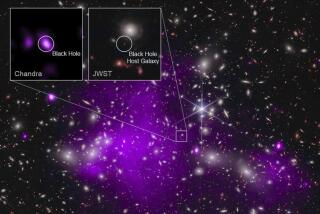Gargantuan black hole baffles scientists
- Share via
Astronomers on the hunt for supermassive black holes have discovered one so monstrous that its mass dominates the central hub of its galaxy in a way that defies scientists’ expectations about how typical black holes behave.
Described in Thursday’s edition of the journal Nature, the black hole may push theorists to revamp their ideas of how these mysterious structures grow and evolve.
Astrophysicists said they were scratching their heads at how thoroughly this gargantuan black hole — seated in the galaxy NGC 1277, about 220 million light-years away — hogs its galactic bed.
Supermassive black holes typically account for just 0.1% of the mass in a galaxy’s stellar bulge, the cluster of older stars huddled around the center. This particular black hole, by contrast, takes up 59% of that central mass, shattering the previous record of 11%.
“This is an oddball,” said Chung-Pei Ma, an astrophysicist at UC Berkeley who was not involved in the research. “It’s a very big black hole for a small galaxy — that’s the most surprising part. It’s a very interesting discovery.”
An international team of scientists documented the giant black hole while peering at the centers of about 800 of the biggest galaxies in the local universe, using the Hobby-Eberly Telescope at the University of Texas at Austin’s McDonald Observatory. The assumption was that the biggest galaxies would hold the biggest black holes, which is what the researchers were really looking for.
The team measured the speed of the stars close to the galactic heart as they orbited around the black hole — the faster they traveled, the more massive the black hole. Their calculations revealed that the black hole at the center of NGC 1277 held the mass of 17 billion suns. (The Milky Way’s black hole, by comparison, is a mere 4 million solar masses.) And yet this black hole, one of the largest known, dominates a galaxy that is only one-tenth the size and mass of the Milky Way.
At first, the researchers thought they had a mistake.
“We were looking at it and we said, ‘That’s got to be wrong,’” said study coauthor Karl Gebhardt, an astrophysicist at the University of Texas at Austin. “So we kind of analyzed it to death.”
The size of a galaxy and the size of its central black hole are thought to be linked, but scientists aren’t exactly sure how. Assessing the mass of a black hole is a time-consuming process, and as a result, fewer than 100 of them have been examined properly. (Gebhardt’s team had logged hundreds of hours of telescope time peering at galaxies for its survey; a typical experiment will get only a few dozen hours at the controls.)
Part of the reason for believing that black holes typically weigh in around the 0.1% mark is that there’s a limit to the amount of matter a black hole can take in at one time, like a crowd trying to push through a doorway. When there’s too much material, the black hole ejects some of it in jets, effectively limiting its growth rate, Gebhardt said.
If that’s true, something strange has been happening in this galaxy to allow the black hole to keep feeding — and the researchers aren’t sure what it could be.
It’s possible, Gebhardt said, that given the team’s large sample of black holes, “of course we’re going to find the weirdest weirdos out there.”
But if they find more, he said, it could mean there’s a whole new class of galaxies that requires fresh explanation. There are already signs that NGC 1277 may have siblings — the researchers have identified other galaxies with similar properties, and they’re currently analyzing the mass of their black holes.
Even if it’s a new class of galaxies, it’s a pretty small one.
“In the observable universe, there’s about 100 billion” galaxies, Gebhardt said. “So this isn’t even the tip of the iceberg. This is a snowflake on top of the tip of the iceberg.”







